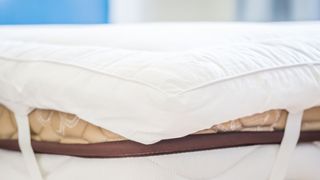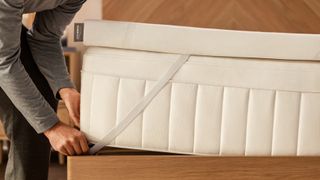6 questions to ask yourself before buying a new mattress topper
Here's how to choose the right mattress topper for you

Mattress toppers can provide instant comfort and help to extend the life of an aging mattress – even the best mattresses don't have an infinite lifespan. Investing in one of the best mattress toppers can completely change the sleep feel of your mattress, with different thicknesses and firmness ratings to choose from. If you think a topper could be for you, here are the questions to consider.
1. Is it actually a topper I need?
Also known as a bed topper, this is a thick layer that sits on top of your mattress, sometimes with straps or an elasticated skirt to anchor it in place on the bed. Anecdotally, there's a slight difference in the market in the US versus the UK. Most US toppers seem to be made of memory foam or occasionally latex foam, while in the UK synthetic fibre-stuffed toppers are very common. (We'll get more into the different filling options in the next section.) These are popular among people wondering whether you can use mattress toppers as a mattress.
However, a topper is a different thing from a mattress protector. These are thin covers, purely designed to protect your bed from spills and stains, and provide an easily washable top layer. Head to our best mattress protector roundup for our top picks.
A mattress topper is also a different thing from a mattress pad. As we explain in our mattress topper vs pad comparison article, these are a padded layer designed to add cushioning to a mattress but without completely changing the sleep feel like a topper will do. They sit somewhere between a protector and a topper when it comes to thickness (they're often around 1-inch thick). They're not really a thing in the UK, but they are in the US.
2. What material should I choose?
Mattress toppers are available in a range of materials, and there's no one material that's better than others – you should pick a topper made from material that will best suit your sleeping style. These are the most common materials you'll come across:
Memory Foam – Used widely to make many of the best mattresses in a box, memory foam toppers mold to your body to help relieve pressure on your joints. They do tend to retain heat, however. (Example: Casper Comfy Mattress Topper pictured in the hero image for this article.)
Gel-infused – If you're a hot sleeper look for a topper made with gel-infused foam to help keep your body temperature lower while you sleep. You can also look for toppers infused with charcoal or graphite as both can help to draw heat away from the body. (Example: Saatva Graphite Mattress Topper review).
Sign up to get the BEST of Tom’s Guide direct to your inbox.
Upgrade your life with a daily dose of the biggest tech news, lifestyle hacks and our curated analysis. Be the first to know about cutting-edge gadgets and the hottest deals.
Latex – Natural latex is bouncy and breathable, as well as being durable. A latex topper will last for longer than other materials and is ideal for those who want to be able to change position easily. They are often fairly expensive though. (See our Naturepedic Adagio Organic Latex Mattress Topper review.)
Synthetic Filled – Usually made from either hollow fiber or microfiber, these toppers are generally slightly cheaper than other materials. Microfiber toppers are soft, with hollow fiber offering a little more support. These materials are also great for allergy sufferers.
Wool – Wool toppers are often organic, and wool is a naturally breathable material. A wool topper is durable and provides a softer feel to the topper.

3. What am I buying a mattress topper for?
Why do you want a mattress topper? Asking yourself this question will help you pick the right topper for your requirements. These are the main reasons people buy toppers:
- To prolong the life of an older mattress by adding an extra layer of padding
- To soften up and help break in a new mattress
- To boost the comfort of a thinner mattress
- To change the feel of a mattress, making it softer, firmer, cooler etc.
4. How thick should my mattress topper be?
Mattress toppers range greatly in thickness, but generally they're 2-4 inches. We wouldn't recommend anything under two inches though, as it's unlikely to provide any extra support or cushioning. A happy medium is around 3 inches, where your pressure points will be supported. A two-inch topper can still provide a little cushioning but may be of more use just to change the 'feel' of your mattress a little.
Some people may enjoy a much thicker topper, but there is the risk here of sinking too deeply into the topper and feeling a little trapped. This can also make changing position quite challenging and could lead to you overheating.

5. What features should I look for?
Besides choosing a topper that's made from the right kind of material and is thick enough to suit your sleeping style, there are other factors to consider. On the material front, do consider whether you're looking for a topper to keep you cool at night or provide more insulation.
It's not uncommon for memory foam toppers to just sit on top of a mattress, with no method of attachment. If you're a very restless sleeper, we'd recommend looking for one with straps or an elasticated skirt to keep it in place. Alternatively, you can add a mattress protector on top and use this to anchor the topper in place – just make sure its deep enough the fit around both your mattress and your topper.
You also need to think about the care of your mattress topper. Figuring out how to clean a mattress topper isn't always straightforward. Check the care instructions to figure out what the deal is before you buy – some toppers are spot clean only, others have removable and machine-washable covers (some have removable covers that aren't machine washable, which is an interesting choice to watch out for). Some thinner toppers with stuffing might be suitable to put in the washing machine in their entirety, assuming they'll fit.
If cleaning isn't straightforward, we'd recommend adding a mattress protector on top to keep it free from stains and dust mites, and air the topper regularly to help keep it fresh.
6. Will a topper help with aches and pains?
If you're waking up with aches and pains, your mattress could be causing you problems. Whilst by no means a permanent solution, a good quality mattress topper could alleviate the pains for a while. Remember though that eventually, your mattress will need replacing.
The choice you go for depends on the type of pain you're experiencing. If you're sinking too far into your mattress your spine will no longer be in alignment, which will cause back pain over time. A firmer mattress topper can help to straighten your spine out (our advice of the best type of mattress for back pain has more advice).
Of course, if your mattress is too firm, that can cause pain too, as a result of pressure buildup. In this case, a softer, plush topper will help you sink in further and make your body less sore at pressure points. Something like the Tempur-Pedic Tempur-Adapt topper excels at cushioning sore joints.

7. Do I actually need a new mattress?
There comes a point where no mattress topper is going to disguise the fact that your mattress needs replacing. Different types of mattresses have slightly different lifespans (we explore more in our article on how long does a mattress last), but there are also other key signs that suggest it needs replacing, even with a topper on top:
- Your mattress has turned yellow with age
- Your mattress has tears or sinks in various places, particularly around the edges
- Your mattress is saggy and unsupportive
- Any slight movement from your partner wakes you up
- You've noticed an increase in allergies or asthma symptoms

Jo Plumridge is an experienced mattress reviewer with several years' experience covering all things mattresses and sleep, and who tests memory foam, hybrid and organic mattresses. What Jo doesn't know about a boxed mattress isn't worth knowing, so naturally we tasked her with producing a series of features for Tom's Guide looking at all aspects of mattresses, from how to pick between latex and memory foam (it's a tricky one), to the seven mistakes people make when buying a mattress for the first time. When testing the DreamCloud Luxury Hybrid for Tom's Guide, Jo said: "I loved the back support and pressure relief it offered. Plus, it looks far more expensive than it is." When she isn’t writing about sleep, Jo also writes extensively on interior design, home products and photography.
